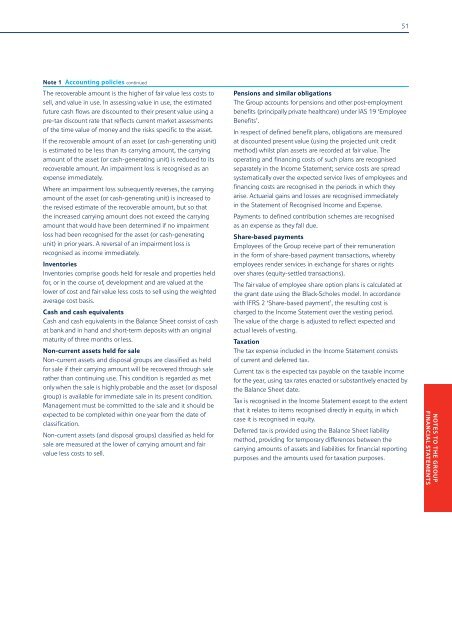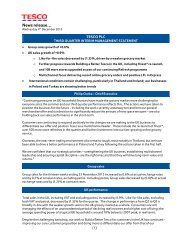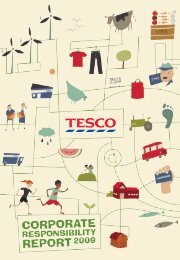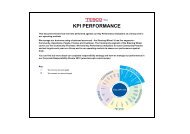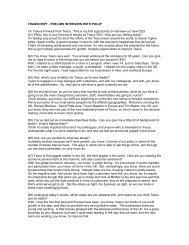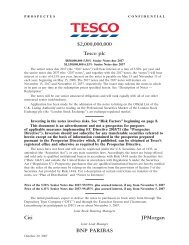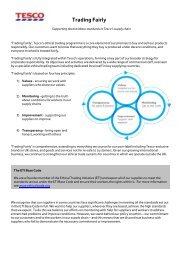Annual Report and Financial Statements 2007 - Tesco PLC
Annual Report and Financial Statements 2007 - Tesco PLC
Annual Report and Financial Statements 2007 - Tesco PLC
You also want an ePaper? Increase the reach of your titles
YUMPU automatically turns print PDFs into web optimized ePapers that Google loves.
Note 1 Accounting policies continued<br />
The recoverable amount is the higher of fair value less costs to<br />
sell, <strong>and</strong> value in use. In assessing value in use, the estimated<br />
future cash flows are discounted to their present value using a<br />
pre-tax discount rate that reflects current market assessments<br />
of the time value of money <strong>and</strong> the risks specific to the asset.<br />
If the recoverable amount of an asset (or cash-generating unit)<br />
is estimated to be less than its carrying amount, the carrying<br />
amount of the asset (or cash-generating unit) is reduced to its<br />
recoverable amount. An impairment loss is recognised as an<br />
expense immediately.<br />
Where an impairment loss subsequently reverses, the carrying<br />
amount of the asset (or cash-generating unit) is increased to<br />
the revised estimate of the recoverable amount, but so that<br />
the increased carrying amount does not exceed the carrying<br />
amount that would have been determined if no impairment<br />
loss had been recognised for the asset (or cash-generating<br />
unit) in prior years. A reversal of an impairment loss is<br />
recognised as income immediately.<br />
Inventories<br />
Inventories comprise goods held for resale <strong>and</strong> properties held<br />
for, or in the course of, development <strong>and</strong> are valued at the<br />
lower of cost <strong>and</strong> fair value less costs to sell using the weighted<br />
average cost basis.<br />
Cash <strong>and</strong> cash equivalents<br />
Cash <strong>and</strong> cash equivalents in the Balance Sheet consist of cash<br />
at bank <strong>and</strong> in h<strong>and</strong> <strong>and</strong> short-term deposits with an original<br />
maturity of three months or less.<br />
Non-current assets held for sale<br />
Non-current assets <strong>and</strong> disposal groups are classified as held<br />
for sale if their carrying amount will be recovered through sale<br />
rather than continuing use. This condition is regarded as met<br />
only when the sale is highly probable <strong>and</strong> the asset (or disposal<br />
group) is available for immediate sale in its present condition.<br />
Management must be committed to the sale <strong>and</strong> it should be<br />
expected to be completed within one year from the date of<br />
classification.<br />
Non-current assets (<strong>and</strong> disposal groups) classified as held for<br />
sale are measured at the lower of carrying amount <strong>and</strong> fair<br />
value less costs to sell.<br />
Pensions <strong>and</strong> similar obligations<br />
The Group accounts for pensions <strong>and</strong> other post-employment<br />
benefits (principally private healthcare) under IAS 19 ‘Employee<br />
Benefits’.<br />
In respect of defined benefit plans, obligations are measured<br />
at discounted present value (using the projected unit credit<br />
method) whilst plan assets are recorded at fair value. The<br />
operating <strong>and</strong> financing costs of such plans are recognised<br />
separately in the Income Statement; service costs are spread<br />
systematically over the expected service lives of employees <strong>and</strong><br />
financing costs are recognised in the periods in which they<br />
arise. Actuarial gains <strong>and</strong> losses are recognised immediately<br />
in the Statement of Recognised Income <strong>and</strong> Expense.<br />
Payments to defined contribution schemes are recognised<br />
as an expense as they fall due.<br />
Share-based payments<br />
Employees of the Group receive part of their remuneration<br />
in the form of share-based payment transactions, whereby<br />
employees render services in exchange for shares or rights<br />
over shares (equity-settled transactions).<br />
The fair value of employee share option plans is calculated at<br />
the grant date using the Black-Scholes model. In accordance<br />
with IFRS 2 ‘Share-based payment’, the resulting cost is<br />
charged to the Income Statement over the vesting period.<br />
The value of the charge is adjusted to reflect expected <strong>and</strong><br />
actual levels of vesting.<br />
Taxation<br />
The tax expense included in the Income Statement consists<br />
of current <strong>and</strong> deferred tax.<br />
Current tax is the expected tax payable on the taxable income<br />
for the year, using tax rates enacted or substantively enacted by<br />
the Balance Sheet date.<br />
Tax is recognised in the Income Statement except to the extent<br />
that it relates to items recognised directly in equity, in which<br />
case it is recognised in equity.<br />
Deferred tax is provided using the Balance Sheet liability<br />
method, providing for temporary differences between the<br />
carrying amounts of assets <strong>and</strong> liabilities for financial reporting<br />
purposes <strong>and</strong> the amounts used for taxation purposes.<br />
51<br />
NOTES TO THE GROUP<br />
FINANCIAL STATEMENTS


